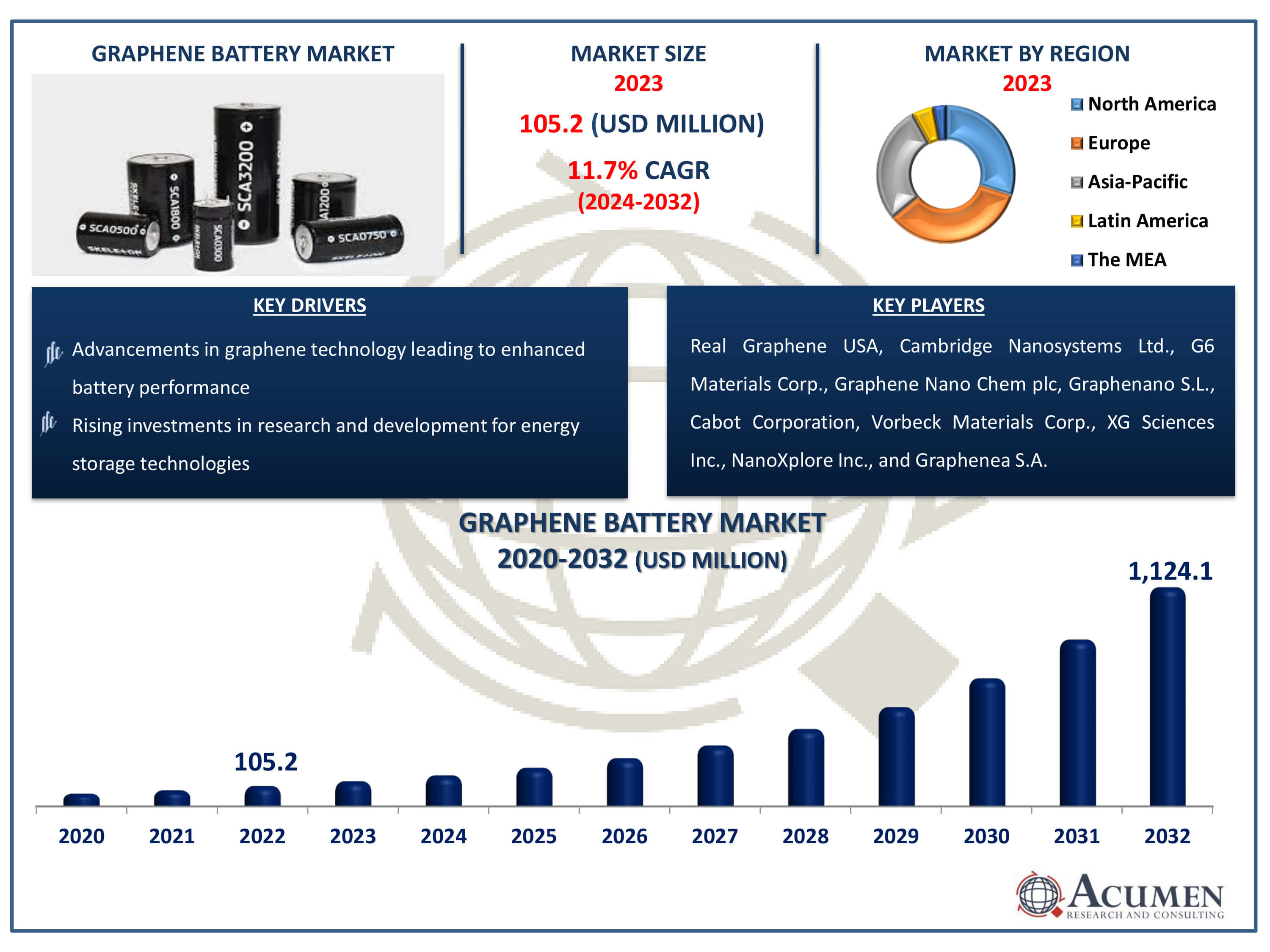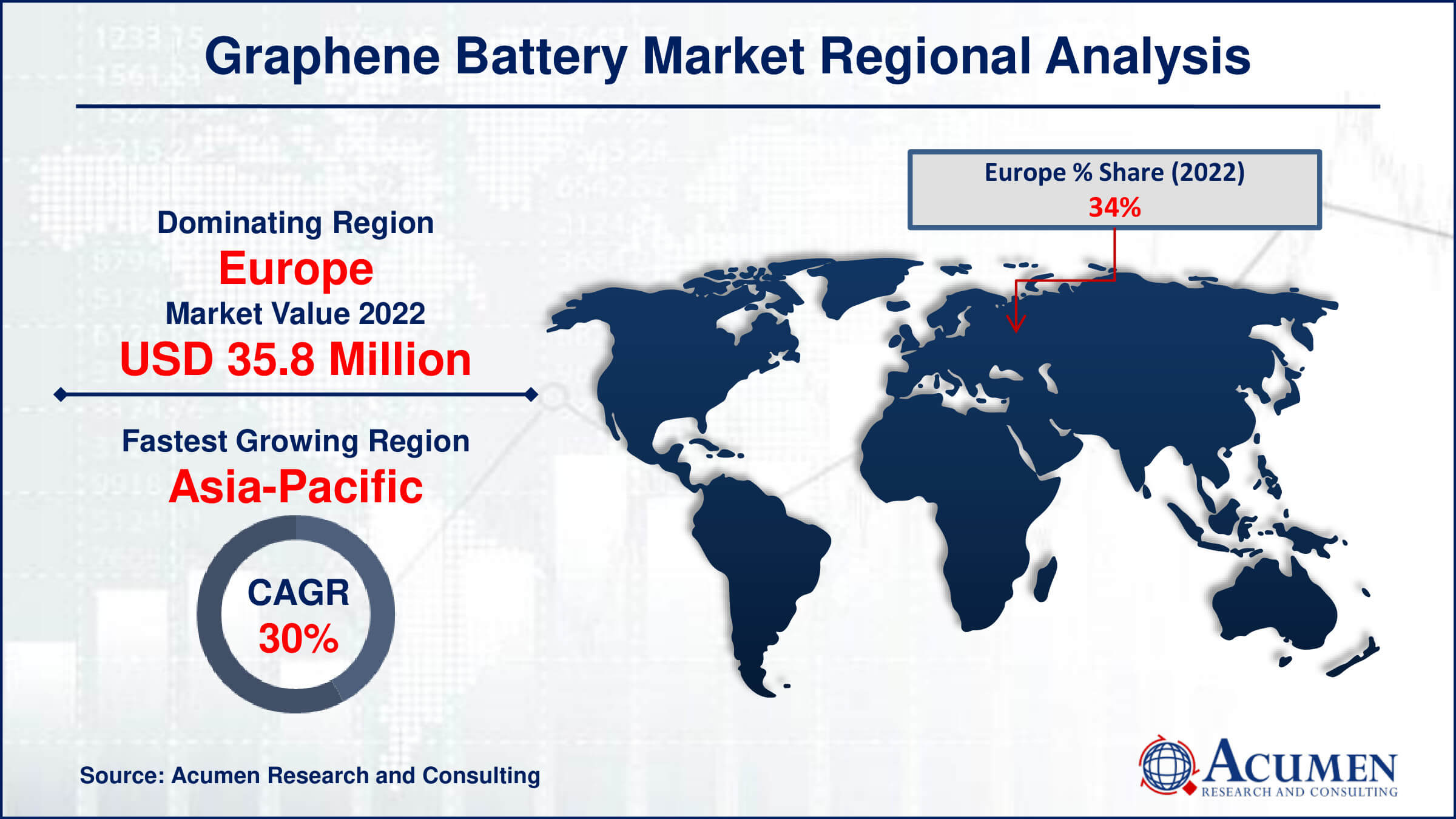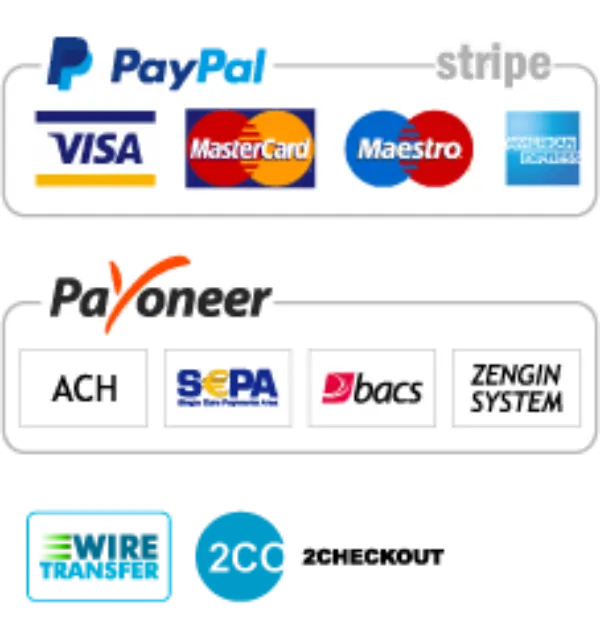Graphene Battery Market | Acumen Research and Consulting
Graphene Battery Market Size - Global Industry, Share, Analysis, Trends and Forecast 2024 - 2032
Published :
Report ID:
Pages :
Format :
The Graphene Battery Market Size accounted for USD 105.2 Million in 2023 and is estimated to achieve a market size of USD 1,124.1 Million by 2032 growing at a CAGR of 27.2% from 2024 to 2032.
Graphene Battery Market Highlights
- Global graphene battery market revenue is poised to garner USD 1,124.1 million by 2032 with a CAGR of 27.2% from 2024 to 2032
- Europe graphene battery market value occupied around USD 35.8 million in 2023
- Asia-Pacific graphene battery market growth will record a CAGR of more than 30% from 2024 to 2032
- Among type, the li-ion batteries sub-segment generated USD 79.9 million revenue in 2022
- Based on application, the automotive sub-segment generated around 32% graphene battery market share in 2022
- Development of graphene-enhanced batteries for medical devices and wearable technologies is a popular graphene battery market trend that fuels the industry demand

Graphene batteries offer a promising pathway for various vertical sectors seeking innovative energy storage solutions. These batteries incorporate components commonly used in electrical applications, such as lithium-ion, lead-acid, and lithium-sulfur, into various battery types. Recent advancements in graphene technology, including the use of few layers and nanoplatelets, have enabled the integration of graphene into battery designs. This has led to significant improvements in energy storage, particularly benefiting handheld electronics and electric vehicles. With their enhanced energy storage capabilities, graphene-based batteries have the potential to revolutionize the performance of electronic devices and automobiles, offering longer-lasting and more efficient power sources. As a result, graphene batteries are increasingly being recognized as a strategic approach to energy storage across multiple industries.
Global Graphene Battery Market Dynamics
Market Drivers
- Increasing demand for electric vehicles and portable electronics
- Advancements in graphene technology leading to enhanced battery performance
- Growing focus on sustainable energy solutions
- Rising investments in research and development for energy storage technologies
Market Restraints
- High production costs of graphene materials
- Limited scalability of graphene battery manufacturing processes
- Regulatory challenges and safety concerns regarding graphene-based products
Market Opportunities
- Expansion of graphene battery applications in aerospace and defense sectors
- Collaboration between industry players to overcome manufacturing challenges
- Integration of graphene batteries in renewable energy storage systems
Graphene Battery Market Report Coverage
| Market | Graphene Battery Market |
| Graphene Battery Market Size 2022 | USD 105.2 Million |
| Graphene Battery Market Forecast 2032 |
USD 1,124.1 Million |
| Graphene Battery Market CAGR During 2024 - 2032 | 27.2% |
| Graphene Battery Market Analysis Period | 2020 - 2032 |
| Graphene Battery Market Base Year |
2022 |
| Graphene Battery Market Forecast Data | 2024 - 2032 |
| Segments Covered | By Type, By Application, And By Geography |
| Regional Scope | North America, Europe, Asia Pacific, Latin America, and Middle East & Africa |
| Key Companies Profiled | Real Graphene USA, Cambridge Nanosystems Ltd., G6 Materials Corp., Graphene Nano Chem plc, Graphenano S.L., Cabot Corporation, Vorbeck Materials Corp., XG Sciences Inc., NanoXplore Inc., and Graphenea S.A. |
| Report Coverage |
Market Trends, Drivers, Restraints, Competitive Analysis, Player Profiling, Covid-19 Analysis, Regulation Analysis |
Graphene Battery Market Insights
Graphene batteries have become a viable option for a number of businesses looking for cutting-edge energy storage technology. These batteries improve energy storage capacity and performance in a variety of applications by using the remarkable qualities of graphene, a highly conductive material. Graphene batteries offer higher energy density and enhanced efficiency by integrating graphene with conventional battery components like lithium-ion, lead-acid, and lithium-sulfur. This opens the door for revolutionary developments in energy storage. The integration of graphene into battery designs has been greatly enhanced by recent developments in graphene technology, such as the creation of few-layer graphene and nanoplatelets. Because of these developments, energy storage capacity has increased significantly, making graphene batteries a competitive substitute for state-of-the-art energy storage technologies.
A domain in which graphene batteries exhibit immense promise is the creation of resilient and effective energy storage mechanisms for electric cars (EVs). With the automobile industry moving more and more towards electric mobility, there is a growing need for high-performance EV batteries. Because of its greater conductivity and energy density, graphene batteries provide a number of advantages over conventional lithium-ion batteries, including quicker charging times, longer driving ranges, and increased durability. Moreover, by tackling important issues like range anxiety and lengthy charging periods, graphene batteries have the potential to completely transform the EV industry. EV manufacturers can now produce vehicles with remarkable performance and durability thanks to graphene batteries, which will encourage more people to choose electric vehicles and contribute to a cleaner, more sustainable transportation ecosystem.
Graphene batteries provide substantial prospects not just for the automobile industry but also for other vertical sectors. Graphene batteries are a versatile and efficient option for a wide range of energy storage demands, from consumer electronics to industrial applications. More sustainable and effective energy use across a range of industries is made possible by graphene batteries, which can power everything from laptops and cellphones to grid-scale energy storage devices. Moreover, incorporating graphene batteries into renewable energy systems is a viable way to improve energy storage performance and encourage the broad use of renewable energy sources. In the global effort to shift away from fossil fuels and towards sustainable energy sources, graphene batteries have the potential to be extremely important in facilitating the effective storage and use of renewable energy.
Graphene Battery Market Segmentation
The worldwide market for graphene battery is split based on type, application, and geography.
Graphene Battery Types
- Lead-Acid Batteries
- Li-Sulfur Batteries
- Li-Ion Batteries
- Supercapacitors
According to graphene battery industry analysis, li-ion batteries stands out as the market leader in graphene batteries for a number of important reasons. Li-ion batteries are a popular option for many applications due to their high energy density, extended cycle life, and comparatively low self-discharge rates. Li-ion battery designers can further improve performance features like increased stability and quicker charging times by incorporating graphene into their designs. Because of graphene's extraordinary conductivity and huge surface area, the battery's overall efficiency and reliability are improved through improved ion diffusion and electron transport. Li-ion batteries are also widely utilized in renewable energy storage systems, portable devices, and electric cars all of which are gaining popularity worldwide. Because of this, the li-ion batteries sector is leading the graphene battery Market due to its excellent performance and adaptability to a wide range of end-use applications.
Graphene Battery Applications
- Automotive
- Healthcare
- Energy
- Electronics
- Industrial Robotics
- Aerospace & Defense
There are a number of strong reasons why the automotive application is the leader and it is expexted to grow over the graphene battery industry forecast period. There is a growing need for cutting-edge energy storage technologies that can effectively power electric vehicles (EVs) as the global automotive industry transitions to electric mobility. Graphene batteries are superior to conventional lithium-ion batteries in a number of ways, including quicker charging times, greater durability, and longer driving ranges. Since performance and dependability are important considerations in automotive applications, graphene batteries are quite appealing due to these qualities. Moreover, graphene's high energy density and lightweight characteristics make it a good fit for electric vehicles (EVs), allowing automakers to create lighter, more energy-efficient cars. In addition, the automobile industry's increasing focus on sustainability and lowering carbon emissions is propelling the use of graphene batteries. Because of this, the automotive application dominates the graphene battery market. This is due to the growing need for electric cars and the pursuit of environmentally friendly transportation options.
Graphene Battery Market Regional Outlook
North America
- U.S.
- Canada
Europe
- U.K.
- Germany
- France
- Spain
- Rest of Europe
Asia-Pacific
- India
- Japan
- China
- Australia
- South Korea
- Rest of Asia-Pacific
Latin America
- Brazil
- Mexico
- Rest of Latin America
The Middle East & Africa
- South Africa
- GCC Countries
- Rest of the Middle East & Africa (ME&A)

Graphene Battery Market Regional Analysis
In terms of graphene battery market analysis, the Asia-Pacific region is the fastest growing region, which is anticipated to develop at the quickest rate during the forecast period due to a number of important reasons. The manufacture of graphene batteries is rising in emerging Asia-Pacific nations due to rapid industrialization and urbanization. Graphene batteries have also become widely used in the area due to the growing demand for consumer devices in the region. The region's growing buying power parity has also boosted car sales, supporting the expansion of the automotive industry, which is a significant consumer of graphene batteries. Notably, the top three countries in the world for graphene battery usage are China, India, and Japan, which solidifies the region's leadership in the industry.
On the other hand, because of their quick technical improvements, it is expected that the market for graphene batteries would expand significantly throughout Latin America and the Middle East and Africa. Graphene batteries are becoming more and more popular as these areas embrace technological innovation and infrastructural development. This is because there is an increasing need for superior energy storage options. The significant growth potential in these areas highlights the graphene battery market's expanding worldwide reach and the growing significance of energy storage technologies in promoting sustainable development.
Graphene Battery Market Players
Some of the top graphene battery companies offered in our report includes Real Graphene USA, Cambridge Nanosystems Ltd., G6 Materials Corp., Graphene Nano Chem plc, Graphenano S.L., Cabot Corporation, Vorbeck Materials Corp., XG Sciences Inc., NanoXplore Inc., and Graphenea S.A.
Frequently Asked Questions
How big is the graphene battery market?
The graphene battery market size was valued at USD 105.2 million in 2022.
What is the CAGR of the global graphene battery market from 2024 to 2032?
The CAGR of graphene battery is 27.2% during the analysis period of 2024 to 2032.
Which are the key players in the graphene battery market?
The key players operating in the global market are including Real Graphene USA, Cambridge Nanosystems Ltd., G6 Materials Corp., Graphene Nano Chem plc, Graphenano S.L., Cabot Corporation, Vorbeck Materials Corp., XG Sciences Inc., NanoXplore Inc., and Graphenea S.A.
Which region dominated the global graphene battery market share?
Europe held the dominating position in graphene battery industry during the analysis period of 2024 to 2032.
Which region registered fastest CAGR from 2024 to 2032?
Asia-Pacific region exhibited fastest growing CAGR for market of graphene battery during the analysis period of 2024 to 2032.
What are the current trends and dynamics in the global graphene battery industry?
The current trends and dynamics in the graphene battery industry include increasing demand for electric vehicles and portable electronics, advancements in graphene technology leading to enhanced battery performance and growing focus on sustainable energy solutions
Which application held the maximum share in 2022?
The automotive application held the maximum share of the graphene battery industry.


